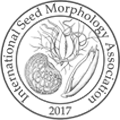Seed ID Forum › Seed ID Forum › Seed Morphology and Identification › Seed ID from South Carolina
This topic contains 10 replies, has 5 voices, and was last updated by ID0000144e0e5e1ad7f4dac9a96d0a2b2fc7b8ec1c6d89666 3 years, 2 months ago.
-
AuthorPosts
-
September 24, 2020 at 7:21 pm #456
These were found in wheat samples submitted to our lab. Any ideas? Feel free to ask any questions if pictures are not clear. Any help is greatly appreciated.
Attachments:
You must be logged in to view attached files.October 6, 2020 at 2:33 pm #461Hello Leanna,
Those are really interesting looking seeds! I’m thinking about what they could be. Could you let us know a few things:
1. Are they very small? It looks like from the scale, but I wanted to be sure.
2. Were they enclosed in anything? There’s a structure in 45731.jpg that looks like a capsule.
3. What is the shape in 3 dimensions? They look D-shaped in outline, and teardrop shaped in 3D to me.
4. Which pictures show the attachment scar or hilum?Thanks for the post! Jennifer
October 13, 2020 at 3:26 pm #462Jennifer,
They are D-shaped. 2-3mm. They are very round with one flat side. That flat side appears to have a “seam” or hilum. The middle one in 45731.jpg is lying on its side with the seam visible. They have what looks like an involucre? See the folds on the flat side of 02915stacked.jpg
October 14, 2020 at 5:27 pm #463Hello Wendy,
Thank you for your reply! Some more questions for you:
– in the picture 45371.jpg, what is the structure on the far left? Is it a capsule or plant material, or something else?
– I see that involucre folded in now, is it easily removed?
– Was the crop locally grown? If not, do you know where it was produced?Thank you, Jennifer
October 16, 2020 at 6:57 pm #464I am not sure what that structure is or even it is part of it. It looks similiar, almost like two “green” ones are stuck together but not exactly the same.
The involucre is not easily removed, when you try it kind of flakes off in small pieces.
Yes, the grain was local to South Carolina.
October 16, 2020 at 6:57 pm #465I am not sure what that structure is or even it is part of it. It looks similar, almost like two “green” ones are stuck together but not exactly the same.
The involucre is not easily removed, when you try it kind of flakes off in small pieces.
Yes, the grain was local to South Carolina.
October 21, 2020 at 7:52 pm #466Jennifer,
We have continued to find these in our wheat samples. Yes I believe they come in a capsule with 3 seeds. The capsule seems to adhere tightly to the seed, however I also found a few where it flaked off. Underneath, the seed are white/cream in color and are distinctly D-shaped as well. They have some sort of structure on the seed-surface that is circular with a spot in the center (chalazal? micropyle?). The flat side of the seed looks like it might have a raphe? I know it’s even harder to tell from photographs. Thank you for at least looking at it.Attachments:
You must be logged in to view attached files.October 21, 2020 at 7:59 pm #471150804- picture of capsule. 3 seed. I believe capsule is sitting with point of attachment/stem up
150859- picture of capsule. capsule is tilted to side to show the round structure on the exterior rounded side of seeds. flat sides are pointing interior.
211409- picture of seed with capsule off. looking at flat side of seed. is that a raphe?
211452- picture of seed with capsule off. looking at profile/side of D-shape seed. it’s hard to see under the flaky capsule but the round structure is shown in this picture.
October 28, 2020 at 4:00 pm #472Hello Leanna,
This is very interesting. I appreciate all the images your lab has sent, and answering my questions. I’m still stuck at trying to place the family, but your information is helping. A couple of thoughts:
– for the image 211409, looking at the flat side of the seed, is the ‘raphe’ you mentioned a groove?
– does you lab have a seed family in mind? I’m leaning to Euphorbiaceae or Rubiaceae based on what I’ve seen so farThank you! Jennifer
November 4, 2020 at 7:24 pm #473Hi Jennifer,
I agree with Euphorbiaceae as a possible family.
Debbie Meyer
January 24, 2021 at 10:05 pm #489Hi Leanna,
How did you go with this ID? My first thought was a damaged Galium or something in Rubiaceae? Cleavers seeds look similar to that when they are separated and it’s a common agricultural weed? These don’t look perfect but maybe in that territory possibly? Not sure if that will help at all. As Debbie and Jennifer have said above, Euphorbiaceae could fit too.
Katherine Nelson
(Australia) -
AuthorPosts
You must be logged in to reply to this topic.



